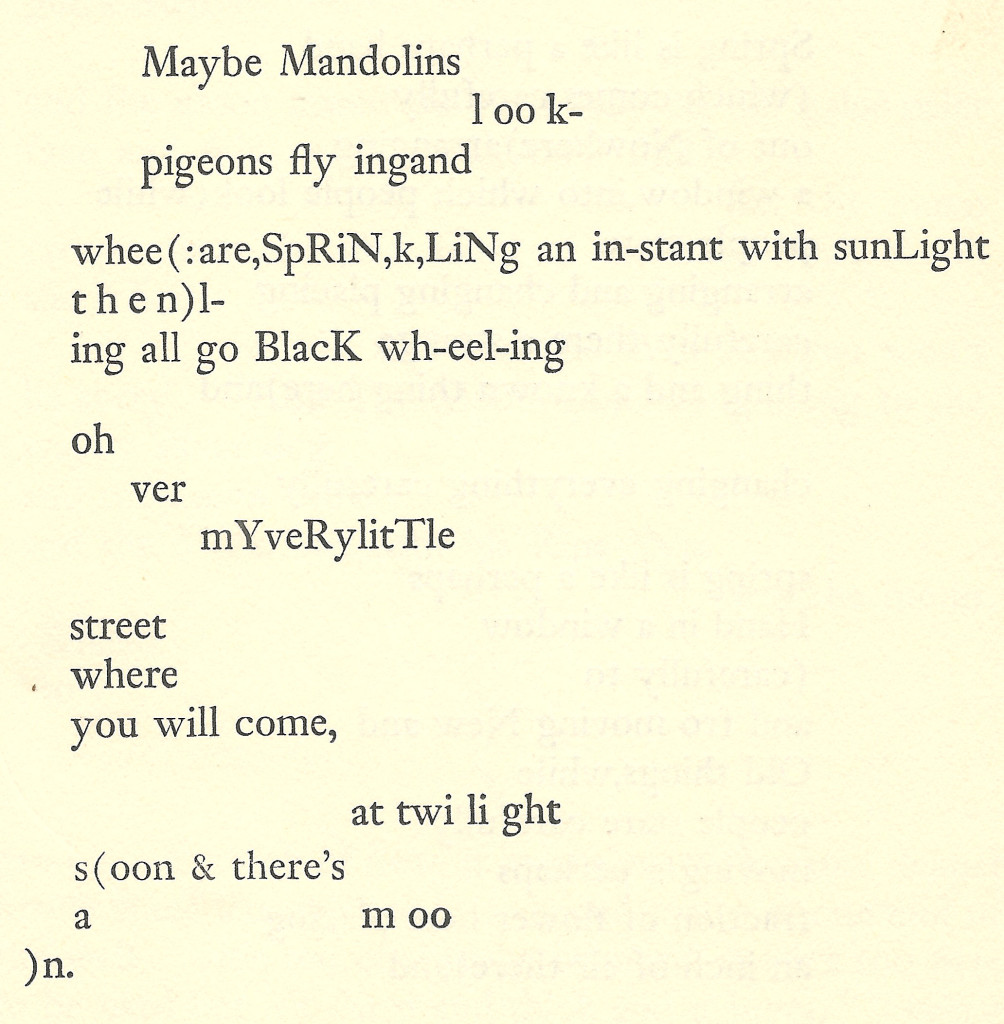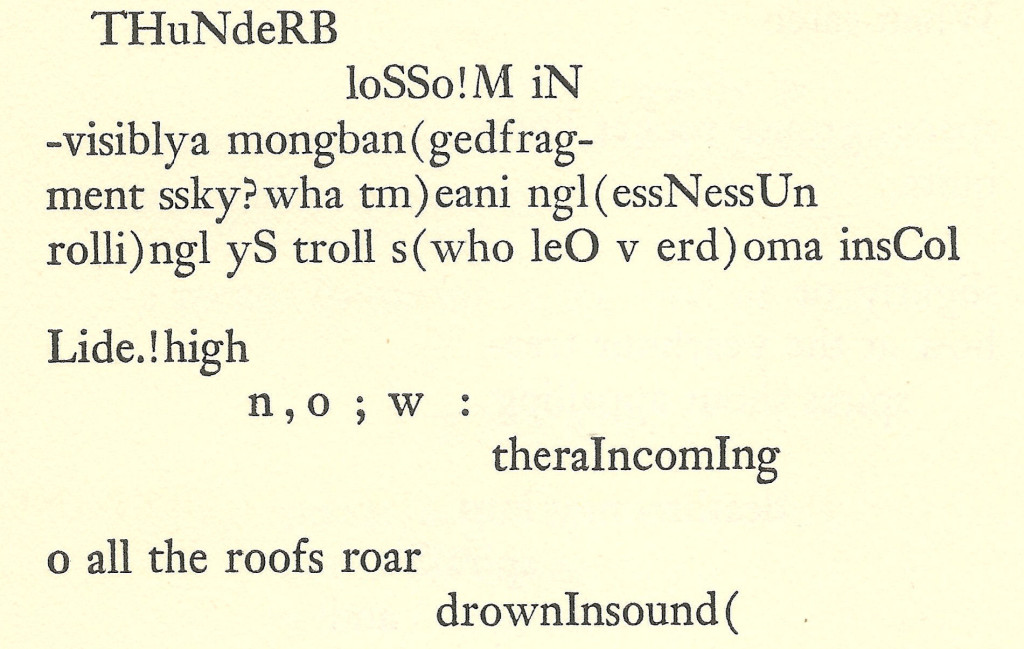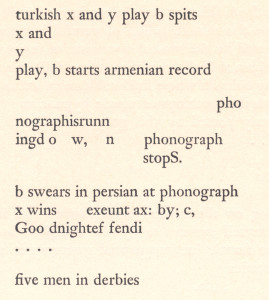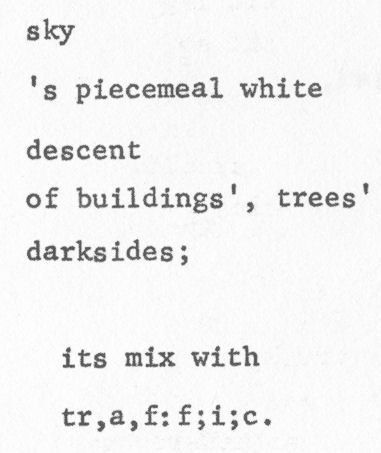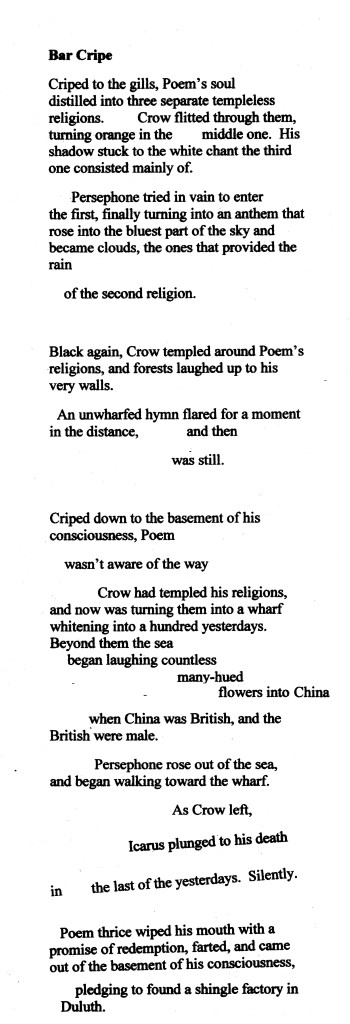Archive for the ‘Announcements’ Category
Entry 1757 — My New Blog Set-Up
Thursday, March 19th, 2015
My new blog’s homepage, which I hope will allow you a choice of four blogs, is here. It is operational, but the three new blogs have nothing in them yet. I consider it an achievement that I even have it to the stage it is now at.
I’d appreciate it if you would click “here” and then go to any of the three new blogs you think you may bisit again when there’s something at them. That will give me at least a little idea of what kind of nuts come here. Thanks!
A second entry point can be found in my Pages to the right as “Bob Grumman BLOGS.”
Now to celebrate the first day of my Blog-Quartet, below is my latest visual poem, thought of and rendered in full yesterday. Not very original, but it won’t be a stand-alone but the dividend of a long division poem now complete but for the rendering. It uses the notes I had here a few days ago . . . no, almost two weeks ago.
Entry 1668 — Additions & Blither
Sunday, December 21st, 2014
First an addition to my taxonomy of awarenesses: I’ve decided to give what I was temporarily calling the “X-ceptual Awareness” one of the names I previously considered, then junked, “the Magniceptual Awareness.” My problem with it was that it was too similar to “the Supraceptual Awareness,” the name I had given to my system’s over-all awareness. I made that problem go away by simply changing “Supraceptual Awareness” to “Cerebral Awareness.” Pretty clever, wot? It makes sense since both the Practiceptual Awareness and the Magniceptual Awareness are in, or mostly in, the cerebrum. And I’m comfortable with the idea of a Sub-Cerebral Awareness located in the cerebellum and other parts of the brain, as well as various places in the secondary nervous system.
Next, a Noun cement that I hope will will cause those of you feeling guilty about getting all this blog’s incredible brilliance for free to express your gratitude with money–to someone on food stamps (due to his actual economic situation, not lies about it, although I did not report the $200 I made as a writer last year in my 2013 request to continue on the dole, nor will I report the $350! I made as a writer this year on my upcoming request). You can do this by sending me $5 or more for an autographed numbered copy of a limited edition of 4 More Poem Poems. It just came off the press. Only 8 copies printed, each with a different cover from the others–in fact, I have just decided to paste a unique original visual image on each cover. (Note: I really think $20 would be reasonable for anyone who is paying that or more for a subscription to any poetry-related magazine whatever.) I claim that no one who likes Joycean foolery with the language and surrealism will find at least one of the poems delightful. And there iz not one (1) but two (2) dreadfully wicked attacks in the collection on our country’s poetry gate-keepers–but only in passing! Remember, Posterity will really be angry with you for not sending me any money!
To take advantage of this Fabulous Offer, send check & your name&address to:
Bob Grumman
1708 Hayworth Road
Port Charlotte FL 33952
Sorry for the begging, folks. I’m really not badly off: I still have credit cards that will allow me to borrow over ten thousand dollar before I max them. I just used on of the cards for $1500, in fact–to have some company try to get the data in an external drive of mine that went bad about a year ago, and has the only copies of a few of my poems, and a lot of my only copies of others’ poems including four or five of Guy Beining’s the originals of which are lost. But I thought it’d be fun to play marketeer for a little while. And at least I didn’t bold-face the above.
* * *
Okay, now to what seems to me an interesting question I just wondered into (note: it’s near impossible now for me not to qualify every opinion of mine in some way like this) while discussing Karl Kempton’s current central project, an exhaustively researched history of visual poetry from pre-history on: what poem should be considered the world’s first major full-scale visual poem? Very subjective, I fear, because of the difficulty in defining both a full-scale poem (for me, to put it simply, it would be a poem that’d be mediocre or worse if not for what it does visually) and a major poem.
I have no idea what poem is but don’t think any of Mallarme’s was because not depending on the visual for anything truly central to them. Nor Apollinaire’s, which seem primitive to me, although I’d have to look at them again to be sure. Such a poem would have to have a highly significant and original visual metaphor at its core to get the prize, in my opinion. Nothing before the twentieth century that I know about does. I think I’d aware the prize to something by Cummings (although I’m not sure what, and he may not have composed what I’d call a full-scale visual poem); if not Cummings, then Grominger’s “silence,” but not with confidence because I don’t know what other superior visual poems came before it.
Here’s a related question I didn’t send Karl: what poet could be said to have been the world’s first serious, dedicated, lyrovisual poets, by which I mean poet who concentrated a fairly substantial portion of his thoughts and energy to lyrovisual poetry–as opposed to Lewis Carroll who (1) was not a lyrical visual poet and (2) wrote light visual poems (which were nonetheless an important contribution to poetry, or Mallarme or Herbert, neither of whom composed more than a few poems that could be called visual–or, from my standpoint, made primary visual poems, or poems whose visual content was at least as important aesthetically as its verbal content.
I’m not even sure Cummings would qualify for consideration since he did not compose all that many poems I’d call primary visual poems. I’d have to go through my volume of his complete poetry to be sure of this, though. So, we have a preliminary question: what poets devoted a fairly substantial portion of his thoughts and energy to lyrovisual poems. My impression is that Kenneth Patchen was one of them. I think Apollinaire probably was, too. Most of the concrete poets seem to have been. I know I’ll annoy a number of you with my next pronouncement: it is that fewer and fewer people calling themselves visual poets devote much, or any, time to the composition of visual poems, preferring to make textual designs (and mostly doing extremely well at it).
Now another addition, this to my thoughts about urceptual personae:
It occurred to me that I made no attempt in yesterday’s entry to indicate the biological advantage of having . . . ursonae, so I’ll try to do that now. I’ll need to go into some detail about the way an urceptual persona is created. For an example, I’ll use the urnemy (no, I’m just foolin’ around: I won’t make that my new name for “the urceptual enemy”). When a baby first sees its father, it will automatically be thrust into its socioceptual awareness[1] where its urceptual persona recognition mechanism is. This mechanism will activate the baby’s urceptual other—due to such stimuli as the father’s face and arms. The father will be unfamiliar to it (probably, although he may have experienced enough of him while in the womb for him to be familiar; or perhaps any face will be familiar enough not to cause the baby pain, or even to cause it pleasure; assume here, though, that the father is unfamiliar to the baby, maybe because he has a beard and is first encountered while he is sneezing or farting). Since the unfamiliar causes pain according to my theory, and pain caused by another person has to be one of the stimuli causing the activation of a person’s urceptual enemy, the baby’s urceptual enemy will become active.
The baby will withdraw as much as possible from its enemy, the father, because urceptual personae automatically activate appropriate certain reflexive behavior. This is value #1 of an urceptual persona.
At this point, I am going to drop the urceptual enemy for not being as good a choice as an example as I first thought. I’ll go instead to the urceptual father. In the scenario I began, the father will almost certainly not continue to activate the baby’s urceptual enemy for long, if he even does so when the baby first encounters him. The baby’s mother will probably be with the father and say something like, “Here’s your daddy, Flugwick (or whatever the kid’s name is),” in a momvoice, accompanied by a mom smile, and many another mo0mfeature, so neutralize the father’s unfamiliarity. And the father will smile and say something in a gentle voice and perhaps, tickle the kid under the chin—certainly something likely to seem pleasant to the kid. In short, little Flugwick’s urceptual persona recognition mechanism will soon activate its urceptual father (I now think a baby will recognize the first male it encounters as its father—but be able to correct the error before long—rather than as a friend; if my hypothesis turns out valid, it will be easy to determine exactly what happens.
Be that as it may, eventually the baby will (in normal circumstance) automatically perceive its father as both a certain shape with a certain voice and smell—and as its urceptual father. The activation of the latter will help it more quickly react to the father appropriately. It will learn from its social environment—mainly its family—the details of appropriate reactions not instinctive like its smile will be until it learns enough to control it.
That an urceptual persona will double the ability of the real person it is attached to cause reactions is it second extremely important biological value. For one thing, this will make people more important than almost anything else to a person, which would obviously help a species survive.
What might be as important to a person as people? Here’s where my superspeculative nature takes over from my speculative nature. The goals a person shoots for may become as important to a person as others, or even himself Beauty, for an artist. As I’ve already tried to demonstrate, an artist will almost surely be motivated to some small or large degree to create an object of beauty to gain others’ approval. But simply to create something of beauty for its own sake can very well be his main motive, or even his only motive. I’m back to the magniceptual awareness where one might go to concentrate on beauty free of interpersonal concerns. Where I increase my speculativeness is in thinking puberty may open a person’s magniceptual awareness—give him doors into it, or significantly increase his doors into it. I strongly suspect a male’s magniceptual awareness is significantly large than a female’s. Just as a female’s anthroceptual awareness is much larger than a male’s. Of course, feminists will take this to be an insult to women, but I don’t see it as that. Well, as a male, I have to think of what I am as superior to females, but nonetheless trying to be objective about it, there’s no reason to say that interpersonal matters require less talent than impersonal matters.
[2] A major awareness is an awareness just under one of the primary awarenesses on my taxonomical chart of the awarenesses.
.
Scientific American Blog Relocated
Sunday, November 30th, 2014
My Scientific American Blog is now here–with a complete table of contents.
AHOY! I finally got Entry 18 done. It is now here. Comments Welcome! Please let me know of any typos or gross factual errors. Warning: it’s me at my abstrusest worst–for over 8,000 words.
Later note: From time to time, I will be revising Entry 18. I hope eventually to correct all the many mistakes in the version first posted.
Entry 1627 — Norman Friedman, RIP
Monday, November 10th, 2014
A day or two ago I got the sad news that Norman Friedman died on the 6th of November. He for many years was probably the foremost critic of E. E. Cummings, one of my three favorite pre-1960 American poets. Certainly I learned more than a little about Cummings (and poetics) from his writings over the years. He was also a very nice man, as I found out when I met him at a literary conference where I presented a paper on Cummings several years ago.
This morning curiosity about him sent me to Wikipedia where, to my shock, I was unable to find an entry on him. Along the way, though, I found an essay of his on Cummings at jstor.org, a site you can read academic writings at for a fee. The fees are way more than I can afford but I took advantage of an offer allowing me to read three essays for free, so am now midway through Friedman’s “E. E. Cummings and His Critics,” (1962).
In his essay, Friedman is making an excellent case for Cummings as what academics should consider a serious poet–i.e., one with a serious outlook on life that he expresses in his poetry. I suppose he is right but for me, “all” Cummings did was celebrate existence, using all the verbal means he could think of in order to able to do that maximally.
Oh, sure, he was diverted from this central concern to take on collectivism (which I applaud) and science (which I don’t applaud) but at his best he did the only thing I believe poets should do, which is use the whole of their language to celebrate existence–which I think requires them at the same time to show by contrast what’s wrong with it. I think what I mean is that a poet should side with, and celebrate, beauty in his poetry, which he can’t do without opposing, and condemning, ugliness (at least implicitly) as when Basho celebrates the beauty of the many moments existence’s best moments combine in his old pond haiku while at the same time implicitly rejects–and I should have used “rejecting: instead of “condemning” earlier in this sentence–existence’s lesser moments, the one’s with only the present in them, or–worse–only some solely intellectual or solely unintellectual present in them. Or nothing at all, unless the nothing that includes all isn’t what many of the greatest minimalist poems are about. (Yeah, I’m going a little over-mystical there.)
You’re in luck. I don’t have time right now to knock out several thousand words on the poetic moment I’m talking about. The traditional haiku moment is an instance of it, but only one instance, whatever the wacked-out anti-Western idolizers of the Far East maintain.
.
Entry 1619 — Evolutionary Theory at its Crudest
Sunday, November 2nd, 2014
First, a short announcement: Anny Ballardini has a lot of good stuff in Truck, which she is driving this month. She just posted something of mine at http://halvard-johnson.blogspot.it/2014/11/bob-grumman.html.
Now for a continuation of my entry of two days ago, with a repetition of the end of the latter. I’m floundering but hope no one notices.
First there were simple crystallizations, or so I believe “informed” speculation has it; certainly, it makes sense to me. Eventually, molecules containing carbon complicate things. Amino acids, stuff like that. Proteins, eventually. I had a not-totally unsound knowledge of dna/ rna/etc at one time; only have what I need to theorize now: in other words, nothing I can gussy up my musings with.)
The crystallizations formed membranes, or some equivalent thereof, and became able to take in substances that would make them grow, and excrete substances that might otherwise destroy them. (None of this is original, by the way, except inasmuch as I get my remembrance of things I’ve read wrong.) When they get large enough, they divide.
CONTINUATION
Eventually, carbon compounds get into the picture. Let’s call what we now have “the alphazoan” (elitism alert, elistism alert!!!) for yesterday’s superior lifeform that will eventually evolve into today’s us. It will begin just bumping into things, some of which it digests, some of which digest its siblings, but—by chance—not it. By chance, it eventually develops a membrane that tends to let in good stuff and block bad stuff.
It multiplies. So do other kinds of zoa with equal adaptations. Some become prey, others become predators it must avoid. Our boy will by luck do the latter.
It will also develop a means of propulsion. Something that makes it go constantly forward (by definition) may be advantageous because it causes it to bump into edibles more frequently, especially stationary ones. At the same time, it will cause it to bump into something that eats things like it more frequently. Conclusion: neither an advantage nor disadvantage . . . at first.
One way things could plausibly go is that its membrane evolves a part, a sensory unit, that is sensitive to touching some other zoan and reacting in some manner. It seems to me this might become a permanent trait although irrelevant for a long time.
Previously, perhaps (bear with me, I’ll be jumping around), the alphazoan will have formed the first biological sensory-unit, my guess is one that is sensitive to light. More exactly, a unit that will react chemically to a photon. Meaningless, until the reaction in some way causes motion. That motion will most likely be either toward or away from light. The alphazoan, necessarily for the purposes of my story Very Lucky, will automatically go toward light, and lit areas will turn out to be good areas for him—lots of prey, say, and few predators.
Meanwhile, others developing similar sensors will go extinct because of being directed toward the dark or not liking the food in lit areas.
Once the alphazoan has evolved a single trait that can use a stimulus in the environment to guide the alphazoan to or from something, the zoan has a kind of will. It can now react with motion to some stimulus. This means it can evolve many other like sensory-unit-motion-effectors such as a unit in its membrane sensitive to the tactile sensation caused by a predator that has touched it, and reacting with motion the other way; or reacting to the touch of a prey the other way. Proto-reflexes.
Eventually, sensory-units will develop that can distinguish shades of light and make more sophisticate behavior possible: e.g. motion toward something of a certain gray which is edible and away from something else a slightly different shade of gray which isn’t, or is a predator.
We are now approaching proto-intelligence, or the first brain. This will occur when a sensory-unit activates a relay-unit rather than a motion-unit, and the relay-unit activates the motion-unit. It will be hit&miss until one of these mechanisms does something biological advantageous, probably nothing new, like moving away from a stimulus of a certain shade of gray, but for the first time giving the alphazoan wider possibilities—i.e., the ability to hook up with any effector in the zoan, rather than one close by. Small advantage, but one which keeps the protobrain in each zoan the alphazoan divides into until greater advantages are possible.
It won’t happen all at once, but incrementally it will come to pass that two relay-cells will share a brain (the zoan will eventually have several “brains”) neither ad- nor disad-vantageously. The next step will be crucial: One relay-cell will develop the ability to inhibit the other. This will pay off when its sensor detects predator ahead and the other relay-unit’s sensory detects prey ahead.
Instead of trying to advance and retreat simultaneously, the zoan will retreat. (Ever luck, remember: many other zoa will develop brains that make them advance instead of holding their ground.)
.
Entry 1557 — Call for Submissions
Tuesday, September 2nd, 2014
In a comment to a comment by Marton Koppany to my 31 September entry, I mention that “what I would do if I thought anyone would send me anything beside you was invite poets to send me a favorite work of theirs by someone else and say why they liked it. I’d post the poems and comments daily here at my blog. (Actually, I thought of inviting them to name their favorite work of MINE and say why they liked it. I decided against it because I’d probably offend too many of them when I told them what they said about the poems was wrong.)
“Seriously, mine good readers, if you would like to participate in such a project, let me know. If I can get five or more to, I’ll set it up. And I promise to use any artwork selected, even if not one of mine, or even by my standards, a poem. The latter, in fact, would be all the better.
“Hey, if I get enough material, I’ll use my Runaway Spoon Press to publish a hard copy for all participants! (Whee.)”
Later I officially announced at Now-Poetry that I would be following through on the idea, but with my usual hit&miss vagueness. Jerry McGuire then asked for further details. Here’s my response to him:
No constraints except a poem (by your definition) that’s no longer than the equivalent of two or three pages, with a text of any length about why you particular like the work you chose. I’m now thinking to make 1 October the deadline, and post the the poems and comments starting then,probably with an introduction of mine. Hard copy to all participants, compliments of the Runaway Spoon Press–eventually, and not likely very fancy. All participants welcome. Send to me at [email protected]. No need to sign up. At first I asked people interested to let me know so I’ could decide whether it would be worth doing, but no think I’ll do it no matter how few become involved. (Which made me think of using ten pseudonyms to post ten different poems I like with comments. And that made be think of using other people’s names, which I maybe should have said here. Like Robert Hass gushing about a poem by Kaz Maslanka and Ron Silliman calling something by Billy Collins the best poem he’s ever read. . . . Another thought: asking people to send me the worst acclaimed poem they know of and why they hate it. If I get enough takers on the first idea–which isn’t original, at all, for I have one, and maybe two, anthologies, consisting of poems various poets like with the comments of the latter–I’ll try the other. I doubt many would be brave enough to go for it, though.
Entry 1540 — A New Work of Mine at Truck
Saturday, August 16th, 2014
Just an announcement today as I ccontinue to try to get my current reviews out of the way (and do seem to slowly be succeeding in doing so). Go here to see “An Evening in June, 1952,” a nostalikuical long division about (sob) my lost boyhood, mostly the part of it spent in boys’ adventure books, but also actual times camping out. Click once on my poem to see a better version of it.
The codes are simple, but I’ve put hints that help down at the far right, if you need them. Further hints available for $12 apiece at HINTS, 1708 Hayworth Road, Port Charlotte FL 33952. (Note, for those of you keeping score: yes, it is a Major Poem.) (Note, for any knownstreamer accidentally here who laughs at the presumption of my declaration, I dare you to present a cogent argument against it. Not that my declaration isn’t intended as a joke, but only in part. I absolutely believe it. I don’t think all or even most, of my poems are major, but if–at my age–I didn’t feel some were it would indicate that I’ve completely wasted my life.)
(((b=a, 5=e)))
.
Entry 1537 — My New Article
Wednesday, August 13th, 2014
I just sent a link that allows those who click it to read my just-posted article at the Journal of Mathematics and the Arts for free to a bunch of ppeople including, I’m sure, some of you. Alas, I’m sure I’ve missed others I should have sent the link to if I weren’t so scatter-brained. If you didn’t get one and want to read my article, just email a request to me at [email protected].
I consider the article as much a little anthology of good stuff as much as anything: it has works by Marton Koppany, Karl Kempton, Irving Weiss, Kathy Ernst, Ed Conti, Kaz Maslanka, John Keats , and–needless to say–me. Those of you what are filthy rich I hope will actually pay to read it. I’m not sure how to do this–I have all kinds of trouble at the site, but this page may help you. I’m having a horrible time with the Internet right now–I’m fairly sure my ccomputer has some king of vvirus. If you pay to read it, it will help make the editors more likely to publish something else of mine, which will be for the good of poetry!!!
.
Entry 1475 — A New Blog?
Thursday, June 5th, 2014
Today, I suddenly had the bright idea to transfer my dumb political thoughts to a new blog. So I started Dichotophilia . . . and soon realized I had misnamed it. Hence, I would have to junk it, and try again, which I’m now much too weary to do. I’m too weary to post a decent entry here, too.
.
Entry 1450 — My Latest Book Review
Sunday, May 11th, 2014
If you go here, you’ll find a preview of my latest book review in a peer-reviewed mathematics journal! If you’re a lot richer than I am, you can buy and offprint! Or subscribe to the magazine. I just read the thing and have to say it’s excellent. Not that I didn’t find a few flaws in it–mainly my saying the same thing about the same poem near the beginning and near the end. I also found a passage I thought a misprint because I couldn’t make heads or tails of it. Then I finally remembered what I’d meant by it–it had to do with the title of a collection of math poems, Crossing the Equals Sign. I said it applied to both mathematics and poetry–meaning the parallel between the equations of mathematics and the metaphors of poetry.
I’m afraid that’s all I have for you today.
Later note: Let me know if you’d like me to email you a copy. My email address is [email protected]. You must promise not to sell copies of it, though. (Haw haw.)
.

